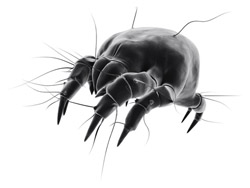 Or Dermatophagoides pteronyssinus. This mite (length: approx. 0.3 mm) lives in house dust and breeds primarily in mattresses and pillows.
Or Dermatophagoides pteronyssinus. This mite (length: approx. 0.3 mm) lives in house dust and breeds primarily in mattresses and pillows.
House dust mites are part of the ecological system in every living space and can be found in our homes during the spring, summer, autumn and winter. The hygiene (or alleged lack thereof) of residents does not affect the number of house dust mites.
The house dust mite is found in all countries and climates, apart from at high altitude. There it is more difficult for them to breed. The house dust mite prefers a temperature between 21 and 26 °C and air humidity of 65-75%. Its diet includes human skin flakes in bedding and mattresses. The health complaints for humans are not caused by the mites themselves, but by their excrement. If this disintegrates, it may form particles so tiny that they can penetrate the alveoli in the lungs. There they will cause an asthma attack. Around 10% of the population of the Western world is thought to be allergic to dust mites.